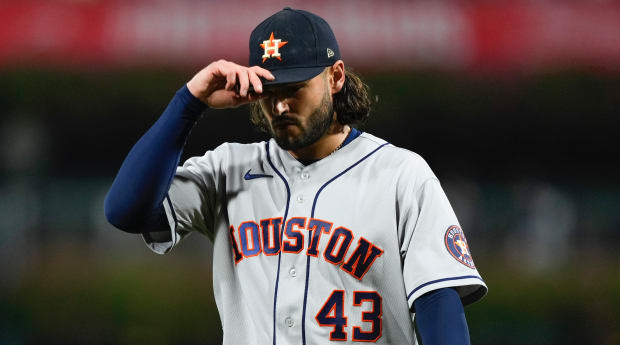PHILADELPHIA — We love conspiracy theories. They are to cognition what paint-by-numbers are to art. Quick, easy fun. World Series Game 3 was one of those made-for-crayon opportunities.
Bryce Harper homered off the first pitch he saw from Lance McCullers Jr., then said something to teammates Nick Castellanos and Alex Bohm in apparent urgency. Twenty Phillies batters came to the plate against McCullers, the Houston starting pitcher. Five of them homered. The Phillies led 7–0 by the time McCullers trudged off the mound in the fifth. That was the final score.
Grab your burnt umber and fill in the blank space: the Phillies must have discovered that McCullers was tipping his pitches.
Run with it if you like. But here’s what really happened at Citizens Bank Park Tuesday night: McCullers threw 82% of his pitches in the narrow range of 82 to 89 miles per hour. Eighty-two percent. McCullers can throw as hard as 96 miles per hour, but he uses his fastball like a demitasse spoon, which is to say only on special occasions.
The Phillies knew this coming in. They could sit soft all night. With the Phillies adopting that approach, McCullers was never going to get them off balance. The best he could do was execute at a high level, which means breaking off nothing but nasty sliders, curves and changeups. But whenever he left his soft stuff in the strike zone—against a red-hot offense that’s cranked out seven runs per game while going 6–0 at home during the postseason—you watched Fireworks Night at the ballpark.
“I got whooped,” McCullers said. “End of story ... This had nothing to do with tipping. I was out there. They beat me. They beat us.”
Says Philadelphia hitting coach Kevin Long, “We went in with a good game plan and the guys did a great job executing it.”

Eric Hartline/USA TODAY Sports
Crayons aside, the real story about how McCullers became the first pitcher in the 118-year history of the World Series to allow five home runs is the story of a bad matchup between a pitcher and a team. If the Phillies didn’t know exactly what was coming, they knew the narrow window of speed in which it was arriving. The pitches were too easy to time.
The real anatomy of a disaster for McCullers begins with the first plate appearance of the game: a walk to Kyle Schwarber in which McCullers threw him six pitches, all of them breaking pitches between 83 and 85 mph. On Oct. 3, Schwarber had homered off a first-pitch fastball from McCullers. There was no way McCullers was going to throw Schwarber another fastball—and Schwarber knew it. He took all six pitches for his walk, never off balance.
The Phillies knew that McCullers had thrown only one fastball to a left-handed hitter all postseason. The Schwarber home run was one of only 29 fastballs McCullers threw to lefties all regular season. They eliminated the fastball to lefties.
There was something else the Phillies noticed in that walk to Schwarber.
“It was either after the first or second pitch,” Castellanos says. “He looked down at his hand or his fingernail like something was wrong. We saw it. He didn’t look comfortable. Everybody noticed.”
The Phillies smelled blood in the water. Rhys Hoskins struck out swinging awkwardly at a slider (so much for tipping). That brought Harper to the plate.
“I didn’t think the pitch to Harper was great,” McCullers said. “It was a bad pitch 0–0. I told myself before the at bat, ‘Don’t let him beat you.’ Castellanos is behind him. He’s no slouch. He’s a great player.”
The last time McCullers faced Harper, he struck him out on three straight curveballs after a first-pitch cutter. Harper went up to the plate sitting on something soft. McCullers gave it to him: an 85-mph curveball floating over the middle of the plate. You might get away with it if you’ve established a fastball that’s 10 miles an hour harder, but not when hitters have ruled out something hard.
After he crossed the plate, Harper celebrated with Castellanos. Then he pulled Castellanos close and told him something. Was it about tipping?
“He told me, ‘This is your time now. It’s your spotlight now,” Castellanos says. “That’s Bryce. He’s a great teammate.”
When Harper returned to the dugout, he called over Alec Bohm, the on-deck hitter behind Castellanos. Did he say something about tipping?
“No,” Harper says. “I can’t even remember exactly what it was. Something about having a good at bat. We talk all the time.”
Castellanos grounded out on a third straight sinker from McCullers.
Bohm led off the second inning. He was sitting on a first-pitch fastball. Why? According to a Phillies source, the team noticed that in the ninth inning of Game 2, after Astros closer Ryan Pressly gave up a double to Bohm on a 1–1 curveball, catcher Martín Maldonado shook his head in disgust. The Phillies understood that head shake to be a sign that the curveball was a mistake. With that last at bat in mind, Bohm sat on a fastball and got it. He smashed it out of the ballpark for home run No. 2.
Two batters later, Brandon Marsh stepped in. Marsh is notorious for having slider bat speed, which is a nice way of saying he has trouble timing velocity. Marsh has seen 713 fastballs from right-handed pitchers this year. He has pulled three of them for hits. Three. Out of 713.
But even with Marsh and his slider bat speed, McCullers ran away from his fastball. He threw three pitches to Marsh, a changeup and two sliders. The speeds: 87, 85, 84. The last was a slider Marsh hit for home run No. 3.
McCullers appeared to settle the game briefly by throwing more cutters and changeups. But more trouble arrived in the fifth. It began with Marsh, who singled on a changeup—one of six pitches he saw on the night from McCullers, again, all between 84 and 89 mph. McCullers threw one fastball to a left-handed hitter all night.
Schwarber was next. McCullers threw him five pitches, none of them fastballs. He threw 11 pitches to Schwarber in total, all of them between 82 and 88 mph. The last was a changeup that Schwarber smashed for home run No. 4.
Next up was Hoskins. McCullers threw him five pitches, all of them between 83 and 87 mph. Hoskins drilled the last of them into the left-field seats for home run No. 5. You are probably catching on by now. It’s beginning to sound like a Duran Duran concert; everything in the 80s.
“I felt like it wasn’t a case of me being all over the place,” McCullers said. “Marsh hit a pretty good pitch, and I got ahead of Schwarber and he hit a changeup. That was kind of a dagger.”
McCullers threw 78 pitches. The last 12 were clocked like this: 89, 86, 86, 87, 85, 84, 88, 84, 83, 86, 87, 85. They resulted in single, homer, homer. Game over.
Though McCullers throws four types of secondary pitches, they lack velocity separation. In Game 3, his curveball averaged 84 (up 1 mph from its usual), his slider also averaged 84 (down 1), his change sat at 87 and his cutter at 88.
In his defense, because of illness, injury and Houston sweeping the first two rounds, McCullers was pitching for only the fourth time in 42 days. He has made four straight starts on 7, 8, 11 and 12 days of rest—a recipe for rust. To his credit, McCullers did not use his lack of regular work as an excuse as he faced a torrent of questions after the game about his stuff and the possibility of tipping. (To his credit as well, McCullers answered every question while standing tall in front of his locker.)
“Absolutely not,” he said about the extra rest affecting his sharpness. “No excuses. I didn’t pitch well. I got beat. My stuff was good. I know that because I checked on the iPad. The stuff was there. I made a couple of mistakes. Unfortunately, they hit them out of the ballpark.”

Matt Slocum/AP
The iPad and its metrics can engender false confidence. Because the movement, spin rate and spin axis fall within optimal parameters does not make it a good pitch. The hitters are the ultimate judge. They will decide the quality of a pitch. If you throw a pitch that the iPad loves in terms of break and spin but is left over the plate for a hitter who is sitting on it, well, it’s not a good pitch.
“I feel like some of the other pitches I made were solid,” McCullers said, carving out the Harper curveball as an exception. “They just had good swings, man.”
That’s the other, less controversial part of the story. The Phillies are swinging it. Their lineup is far deeper than the Houston lineup. They are playing with supreme confidence in a madhouse of a ballpark. Such is their swagger that they consider a pitcher in trouble against them just on the sight of the guy checking his fingernail after a pitch. You are not beating them by throwing 82% of your pitches around the same speed.
“Listen, I am who I am,” McCullers said. “I’m going to throw a lot of off-speed. Everyone knows that. But it was not a well-located pitch [to Harper]. It could have been a well-located pitch and he did the exact same thing. I am who I am. These are things I can visit in the offseason, trying to add some other pitches.”
McCullers is in line to pitch Game 7 if the series gets that far. He must overhaul his approach and throw more fastballs or Houston manager Dusty Baker has to skip a guy who had been a clutch postseason pitcher. Until Game 3, only one pitcher could match McCullers’s postseason marks of 9.9 strikeouts per nine innings and a 2.77 ERA over at least 60 innings: the great Bob Gibson.
But Philadelphia tore that reputation to shreds. This is how the Phillies roll these days, especially at the Bank. The have outhomered the opposition 17–6 at home this postseason. Up and down the lineup, they hit the ball hard. They hit it far. And they hit it like they know what’s coming.







